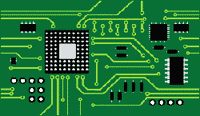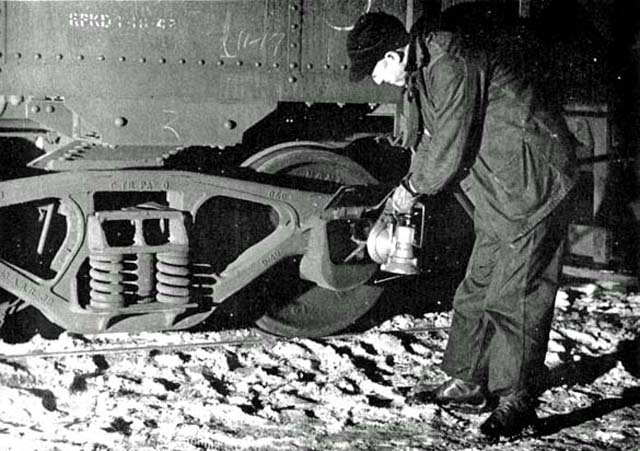
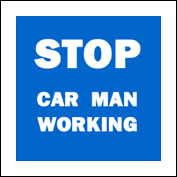
They are part of a system of check, and double check. Every time a train arrives or departs a yard, a carknocker checks each car of that train. They work like a relay team, passing the inspected trains from yard to yard and checking each time to make sure no defects have occurred while the cars have been moving over the road or while they've been processed within the yard.
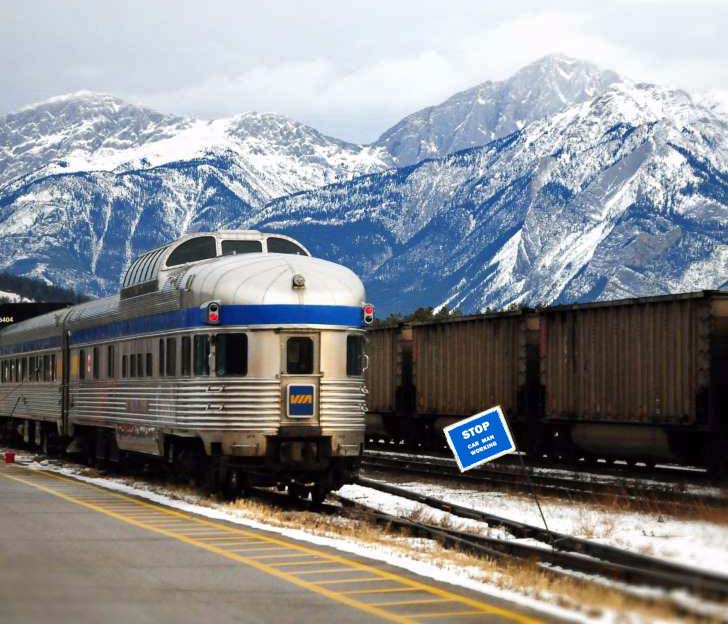
The first order of business is a safety ritual known as "line, lock, and display".
Before performing any work the track switch behind the train to be inspected must be lined in order to divert other equipment away from it. The switch is locked to assure that. A blue flag by day, or blue light by night, are displayed to warn other employees work is in progress and the car or cars being inspected are not to be moved or coupled to. Only then is it safe to complete such tasks as, say, installing an SBU (Sense and Braking Unit), inspecting the cars, or performing a brake test.
The SBU, an end-of-train device with a flashing red light, will transmit to the crew in a locomotive's cab the air brake line pressure at the tail-end, and also the train's forward or reverse motion. In case of an emergency brake application, the SBU will also instantaneously "dump" the air from the tail-end at the same time that it's being exhausted by the locomotive, making for safer and faster applications of the brakes throughout the train's length.
Once a train has been assembled on the departure track an SBU is attached to the coupler on the last car then connected to the train's air brake line. After isolating the last car's air brake system from the rest of the train the engineer is free to do an emergency brake test. Once it has been confirmed the brakes have been fully applied the carknocker must then walk the length of the train scanning for:
- Un-released hand brakes;
- Sticking or loose brake shoes;
- Damaged couplers, air hoses, and brake gear;
- Excessive wear on the flanges and treads of the wheels;
- Bent or broken safety appliances, such as ladders and grab irons;
- Loose or missing strapping and other load blocking devices;
- Shifted loads and;
- Anything else that could in any way cause damage to the equipment, the track, wayside signals, structures, or injure employees and the public.
As the train heads onto the mainline the departure track is cleared once the carknocker's blue flag is retrieved.
In addition to all this work there are programmed maintenance inspections of cars in the shops, scanning by hot box and dragging equipment detectors located at frequent intervals along the mainline, inspections of trains that crews give each other's trains as they pass out on the line, and, of course, the carknockers watch everything as trains depart or enter the yard.
If everything passes inspection the engineer or conductor of the train will be given an "OK the PK" over the radio and the train may proceed. (PK is a very old abbreviation for Pins and Knuckles, as in link and Pin couplers, and Knuckle couplers.) OK the PK, now you know.
"Check, and double check" - Purloined and modified from a CPR employee news article.

This website does NOT use cookies . If a website needs to store data about you, then we believe they should store it on their server, not on your device. This website does NOT store information that you voluntarily give us via email or other direct contact without your permission. We will not share, rent, or sell your information to any third party. We will use your data only to respond to you regarding the reason you contacted us. Unless you ask us to we will not contact you via email. This website contains links to other sites. Please be aware that we are NOT responsible for the content or privacy practices of such other sites. You should be aware when leaving our site that other sites may collect personally identifiable information.
. If a website needs to store data about you, then we believe they should store it on their server, not on your device. This website does NOT store information that you voluntarily give us via email or other direct contact without your permission. We will not share, rent, or sell your information to any third party. We will use your data only to respond to you regarding the reason you contacted us. Unless you ask us to we will not contact you via email. This website contains links to other sites. Please be aware that we are NOT responsible for the content or privacy practices of such other sites. You should be aware when leaving our site that other sites may collect personally identifiable information.
Each time you use this web site you acknowledge and agree to be bound by the terms of this web site. OKthePK, the Canadian Pacific Railway Set-off Siding, and their service or content providers, do not accept any liability for your use of the web site. You use it at your own risk. The web site is provided on an "as is" and "as available" basis, without any representation, warranties, or conditions of any kind. While every attempt is made to publish accurate data this web site is not responsible for any errors or omissions in its content.
In the United States of America
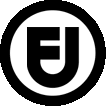
In Canada
The Canadian concept of "Fair use" is known as "fair dealing" and is similar to that in the UK and Australia. The fair dealing clauses (10) of the Canadian Copyright Act allow users to engage in certain activities relating to research, private study, education, parody, satire, criticism, review, or news reporting. With respect to criticism, review, and news reporting, the user must mention the source of the material, along with the name of the author, performer, maker, or broadcaster for the dealing to be fair.
Prior to 2011, fair dealing in Canada was not definitely found to contain exceptions for parody (unlike fair use in the United States), but the Copyright Act has since been amended to include parody and satire (along with educational use) under its fair dealing provisions.
In considering fair dealing the Supreme Court of Canada makes the following general observation:
It is important to clarify some general considerations about exceptions to copyright infringement. Procedurally, a defendant is required to prove that his or her dealing with a work has been fair, however, the fair dealing exception is perhaps more properly understood as an integral part of the Copyright Act than simply a defence. Any act falling within the fair dealing exception will not be an infringement of copyright. The fair dealing exception, like other exceptions in the Copyright Act, is a user's right. In order to maintain the proper balance between the rights of a copyright owner and users' interests, it must not be interpreted restrictively. Furthermore, by taking "a liberal approach to the enumerated purposes of the dealing", the Court has made fair dealing more flexible, reducing the gap between this provision and United States fair use.
One Supreme Court criteria regards the purpose of the Dealing. Is it for research, private study, criticism, review, or news reporting (or additionally since 2011, education, parody, or satire)? It expresses that "these allowable purposes should not be given a restrictive interpretation or this could result in the undue restriction of users' rights."
On 2 Jun 2010, the Government of Canada introduced Bill C-32, An Act to amend the Copyright Act. A summary of the changes proposed by this bill in terms of fair dealing notes that C-32 "expands the scope of the fair dealing exception at section 29 of the Act to include new purposes: education, parody, or satire". The stated aims of the revised bill were also to "permit businesses, educators, and libraries to make greater use of copyright material in digital form". Bill C-32 had not passed by the time the minority Conservative government faced a vote of no-confidence and subsequently fell on 25 Mar 2011.
On 29 Sep 2011, the bill was re-introduced to the Forty-first Parliament as Bill C-11. With the backing of a majority Conservative government, this version of the Copyright Modernization Act has passed into law. Simply put, the fair dealing amendment in Section 29 of Bill C-11 expands the first criteria for evaluating fair dealing, the Purpose of the Dealing, to include education, and parody, or satire.
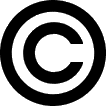
If you believe that content located on OKthePK infringes your copyright, please immediately notify OKthePK by eMail with the subject line containing the words "Infringement Notification". Following that initial eMail you will be required to provide the information described below in writing.
You may be held liable if you make material misrepresentations in an Infringement Notification. Thus, if you are not sure content located on OKthePK infringes your copyright, you should first contact an attorney.
All Infringement Notifications must include the following:
- The physical signature of the copyright owner or the person authorized to act on the copyright owner's behalf;
- Identification of the copyright claimed to have been infringed;
- A description of the nature and location on the OKthePK web site of the content that you claim to infringe your copyright in sufficient detail to permit OKthePK to find and positively identify that content;
- Your full name, address, telephone number, and email address;
- A statement by you, that you believe in good faith, that the use of the content that you claim infringes your copyright is not authorized by the copyright owner, or such owner's agent, and, under penalty of perjury, that all of the information contained in your Infringement Notification is accurate, and that you are either the copyright owner, or a person authorized to act on their behalf.
For your initial notification to this website please use the Telegraph Form for your first contact.
for your first contact.
A large number of photos used on this web site do not identify the photographer. This is not because of a reluctance to do so, but is solely because the photo file has not been attributed to the photographer. There are several ways to attach a photographer's name to a photo. The simplest method would be to use the subject's name, date taken, and photographer's name as part of the computer file name. e.g. svr 19 mcEwan 22 sep 2000 william Slim .jpg (Remove these blank spaces in actual use, they're only here so this page displays correctly on a smartphone.)
Another method is to add a caption line as part of the image, along the bottom, such as this example:
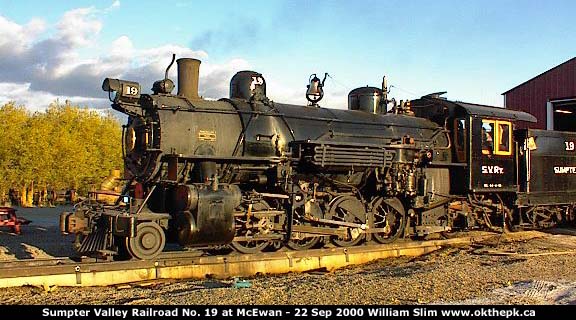
(Some photographer's add their name and date on top of an image but this is not professional practice as it detracts from the image.)
A third option is to use PhotoShop software. This program provides the ability to attach categorized data to a photographic file such as the date, photographer's name, title, description, key words, camera settings, etc.
When there is no identifying date or name readily available for a photo then it will be assumed the photographer wishes to remain anonymous so the photo will be labeled "Date? Photographer?".
These particular OKthePK pages were specifically designed for Google Chrome, FireFox, Microsoft Edge, and Opera running on the Windows 10 operating system. This website may not function correctly on Microsoft Internet Explorer unfortunately as it is now outdated software. Pages currently display on device screens with a width of 640 to 2,560 pixels. Other browsers, operating systems, or resolutions may be problematical. If you have a problem please use the telegram form.
Any pages containing Flash presentations require the Adobe Flash plug-in. Adobe .pdf files are rarely used on this site due to their slow downloading time and large bandwidth requirements. You will be warned should there be a link to a .pdf file.
OKthePK HTML (Hyper Text Mark-up Language) pages conform to W3C (World Wide Web Consortium) HTML 5 and each page is validated to confirm that. Cascading Style Sheets (CSS3) have been employed on all pages. Also, Javascript may be used on some pages.
These web site pages contain internal and external links to web sites located on the Internet. Occasionally the external links may not function (link rot) as page servers go offline either temporarily, or permanently, or the author may just remove the page, or web site, from the Internet. All links are checked for functionality once a week.
This web site first began publishing railway stories and articles to the World Wide Web way back in April of 1995. It was then known as the Canadian Pacific Victoria Division.
That initial web site evolved into the Cordova Bay Station web site which went online for the first time in August of 2000.
A unique story appeared on Cordova Bay Station each month for eleven years with only one exception. Over time the name was shortened to Cordova Station and a new physical location was built but the content remained pretty much the same until a conceptual change occurred with the birth of the Canadian Pacific Set-off Siding web site.
web site.
The Canadian Pacific Set-off Siding is a subset of Cordova Station containing only CP material gathered or created during assembly and publication of Cordova Station.
By July 2010 Cordova Station had become so popular that readers accessing the web site exceeded the bandwidth permitted by my internet hosting company. This resulted in a payment request from the host that would double the hosting fee. Since the two web sites did not generate any income to offset their operation an increase in expenses was not acceptable.
had become so popular that readers accessing the web site exceeded the bandwidth permitted by my internet hosting company. This resulted in a payment request from the host that would double the hosting fee. Since the two web sites did not generate any income to offset their operation an increase in expenses was not acceptable.
The solution to continued operation resulted in the creation of a new web site named "OKthePK" at a hosting company providing unlimited bandwidth and storage for a reasonable fee.
at a hosting company providing unlimited bandwidth and storage for a reasonable fee.
OKthePK is updated 7 days a week with any Canadian Pacific Railway news or articles being archived on the Canadian Pacific Set-off Siding web site as was done in the past with Cordova Station.
OKthePK Mobile Canadian Railway News for smartphones commenced publishing on 12 Mar 2011 along with a re-design of the web site. On 4 Feb 2013 Canadian railway news for smartphones was discontinued but re-commenced on 27 Oct 2013 utilizing CSS (Cascading Style Sheets).
commenced publishing on 12 Mar 2011 along with a re-design of the web site. On 4 Feb 2013 Canadian railway news for smartphones was discontinued but re-commenced on 27 Oct 2013 utilizing CSS (Cascading Style Sheets).
Effective 26 Aug 2019 the website was redesigned to display properly on the five major browsers, Chrome, FireFox, Edge, Opera, and Safari at resolutions ranging from 640 pixels wide to 1,920 pixels wide. At that time the Safari browser would not display the website correctly as Apple had not updated Safari since 2012. With the release of their operating system update IOS 13 in early October 2019 their Safari browser now displays this website correctly.
Offering 7 days per week service leads to a constant demand for railway news, information, and photographs. If you believe you have newsworthy or exceptional Canadian photos please send them along for inclusion with a news story or for the "Photo of the Week Award".
Today the web site continues to evolve in an attempt to improve and keep readers interested. For the latest changes to OKthePK see the Website Revisions page.
page.
1. "Imagine my surprise when I opened my blog stats today and that found a higher than normal number of readers had viewed my blog since yesterday. Let it be known that it wasn't the quality of my recent posts (non-existent for the most part) that explained this anomaly. A quick look into traffic sources showed that today, one source was the cause of over half the reads. I thought, "Gee, I am not that interesting that someone would read 55 of my posts. Or am I?... Na-aa! Not likely." It had to be something else. Thanks to Google, I typed in the URL and was directed to a very cool site indeed. It has plenty to look at (great photography) and plenty to read (articles of all sorts, not too long). It is international in flavour and Canadian in every way. The Canadian Railway News: www.okthepk.ca. If you enjoy the news of railways in Canada and around the world, why not take a side step from this blog over to their web site. You won't be disappointed." - Christine Powless - True Tales from a CPR Section House.
2. "If you haven't done so already, you might want to add OKthePK to your bookmarks and regularly visit it. It's a web site that chronicles the goings-on of railway matters in Canada, including Canadian companies like Bombardier. I find their railway news to be interesting and informative and it helps me keep on top of what's going on in the industry" - Railway Bob.
3. "You have an EXCELLENT web site to obtain current up to date and archival news material on rail transportation, rail museums etc. in Canada, the United States, also overseas." - Thomas Ronayne.
4. "Enjoy keeping up with the news articles. The other information found on the site is useful. I disagree with some of the editorial comments from time to time, and don't like how the photos often get labelled as "date/photographer unknown". While it's obvious that some photos, due to their age will be "Date/Photographer unknown", there are plenty of photos included with the news articles where a very short search would reveal the source of the photo. It feels like lazy reporting/journalism. That said, I still feel that the site has more benefits than downfalls. Just my personal opinion." - Author unknown.
5. "I enjoy your comments correcting stupid stuff in the articles." - Author unknown.
6. "Very informative on rail news, as a retired railroader I like to keep informed on what is happening in the rail industry. The rail photos are excellent and I look forward to them each week." - Author unknown.
7. "Plus, daily updates very thorough. Minus, need to have all features like World News work on tablets and phones. Love your work, thanks !" - Author unknown. ("Be careful what you wish for." - William Slim.)
8. For a great collection of articles and documents related to the CPR over the years, see Canadian Pacific Railway - Stephen R. Bown, "Dominion: The Railway and the Rise of Canada", Page 379.
- Stephen R. Bown, "Dominion: The Railway and the Rise of Canada", Page 379.
This website's Data Wrangler is William Slim , alias the Carknocker - "I love the smell of creosote in the morning". To send a message to the Carknocker please click on the C.P.R. telegraph sign below:
, alias the Carknocker - "I love the smell of creosote in the morning". To send a message to the Carknocker please click on the C.P.R. telegraph sign below:



